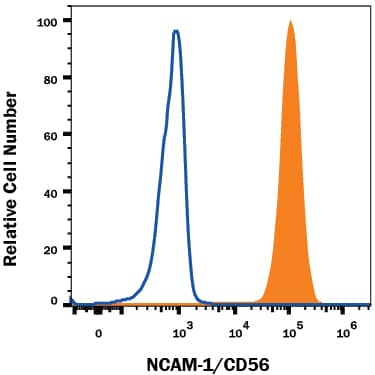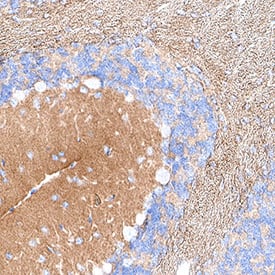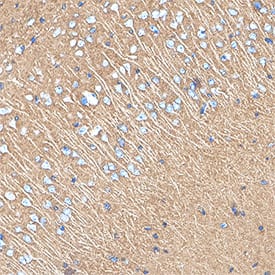Mouse NCAM-1/CD56 Antibody
R&D Systems, part of Bio-Techne | Catalog # MAB7820


Key Product Details
Species Reactivity
Validated:
Cited:
Applications
Validated:
Cited:
Label
Antibody Source
Product Specifications
Immunogen
Leu20-Thr711
Accession # P13595
Specificity
Clonality
Host
Isotype
Scientific Data Images for Mouse NCAM-1/CD56 Antibody
Detection of Mouse NCAM‑1/CD56 by Western Blot.
Western blot shows lysates of Neuro-2A mouse neuroblastoma cell line. PVDF membrane was probed with 0.1 µg/mL of Rat Anti-Mouse NCAM-1/CD56 Monoclonal Antibody (Catalog # MAB7820) followed by HRP-conjugated Anti-Rat IgG Secondary Antibody (Catalog # HAF005). A specific band was detected for NCAM-1/CD56 at approximately 120 kDa (as indicated). This experiment was conducted under reducing conditions and using Immunoblot Buffer Group 1.Detection of NCAM‑1/CD56 in Neuro‑2A Mouse Cell Line by Flow Cytometry.
Neuro-2A mouse neuroblastoma cell line was stained with Rat Anti-Mouse NCAM-1/CD56 Monoclonal Antibody (Catalog # MAB7820, filled histogram) or isotype control antibody (Catalog # MAB006, open histogram), followed by Allophycocyanin-conjugated Anti-Rat IgG Secondary Antibody (Catalog # F0113). View our protocol for Staining Membrane-associated Proteins.Detection of NCAM-1/CD56 in Mouse Cerebellum.
NCAM-1/CD56 was detected in immersion fixed paraffin-embedded sections of mouse cerebellum using Rat Anti-Mouse NCAM-1/CD56 Monoclonal Antibody (Catalog # MAB7820) at 5 µg/ml for 1 hour at room temperature followed by incubation with the Anti-Rat IgG VisUCyte™ HRP Polymer Antibody (Catalog # VC005). Before incubation with the primary antibody, tissue was subjected to heat-induced epitope retrieval using VisUCyte Antigen Retrieval Reagent-Basic (Catalog # VCTS021). Tissue was stained using DAB (brown) and counterstained with hematoxylin (blue). Specific staining was localized to the cytoplasm and neuropils. View our protocol for Chromogenic IHC Staining of Paraffin-embedded Tissue Sections.Applications for Mouse NCAM-1/CD56 Antibody
CyTOF-ready
Flow Cytometry
Sample: Neuro‑2A mouse neuroblastoma cell line
Immunohistochemistry
Sample: Immersion fixed paraffin-embedded sections of mouse cerebellum and mouse cortex
Western Blot
Sample: Neuro‑2A mouse neuroblastoma cell line
Formulation, Preparation, and Storage
Purification
Reconstitution
Formulation
Shipping
Stability & Storage
- 12 months from date of receipt, -20 to -70 °C as supplied.
- 1 month, 2 to 8 °C under sterile conditions after reconstitution.
- 6 months, -20 to -70 °C under sterile conditions after reconstitution.
Background: NCAM-1/CD56
NCAM-1 (Neural adhesion molecule-1; also CD56) is a 120-190 kDa glycoprotein member of the Ig Superfamily. It is expressed on multiple cell types, both in the embryo and adult. Here, it serves as both an adhesion molecule and a receptor for multiple ligands, including as FGFR, PDGF, GDNF and agrin. On the cell surface, it is a cis-oriented homodimer that can form homodimers in-trans with other cis-homodimers. In the embryo, NCAM-1 is polysialylated (PolySia), and shows a MW of 200-220 kDa in SDS-PAGE. This polysialylation reduces the ability of NCAM-1 to dimerize. Mature mouse NCAM-1 is a 1096 amino acid (aa) type I transmembrane (TM) protein (aa 20-1115). It possesses a 692 aa extracellular region (aa 20-711) and a 386 aa cytoplasmic domain. The extracellular region contains five consecutive C2-type Ig-like domains (aa 20-492) followed by two FN type-III domains (aa 497-692). Multiple splice variants exist. There is a 140 kDa TM variant that shows a deletion of aa 810-1076, and a 120 kDa variant that is GPI-linked and shows a 24 aa substitution for aa 702-1115. A third potential variant contains a five aa substitution for aa 601-1115. Over aa 20-711, mouse NCAM-1 shares 99% and 95% aa identity with rat and human NCAM-1, respectively.
Long Name
Alternate Names
Gene Symbol
UniProt
Additional NCAM-1/CD56 Products
Product Documents for Mouse NCAM-1/CD56 Antibody
Product Specific Notices for Mouse NCAM-1/CD56 Antibody
For research use only


